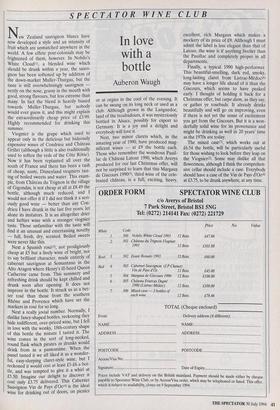SPECTATOR WINE CLUB
In love with a bottle
Auberon Waugh
New Zealand sauvignon blancs have now developed a style and an intensity of fruit which are unmatched anywhere in the world. A few effete post-colonials may be frightened of them, however. In Nobilo's White Cloud('), a blended wine which should be drunk within a year, the sauvi- gnon has been softened up by addition of the down-market Muller-Thurgau, but the taste is still overwhelmingly sauvignon — nettly on the nose, grassy in the mouth with good, strong flavours, but less extreme than many. In fact the blend is heavily biased towards Muller-Thurgau, but nobody would ever guess it, and this might explain the extraordinarily cheap price of £3.99. Highly recommended for drinking this summer.
Viognier is the grape which used to appear only in the delicious but hideously expensive wines of Condrieu and Château Grillet (although a little is also traditionally used to soften the reds of the Cote Rotie). Now it has been replanted all over the south of France and there has been a rash of cheap, nasty, Disneyland viogniers tast- ing of boiled sweets and water. This exam- ple, from Château du Trignon in the village of Gigondas, is not cheap at all at £8.49 the bottle, although much reduced, and I would not offer it if I did not think it a seri- ously good wine — better than any Con- drieu I have drunk in the last five years, let alone its imitators. It is an altogether drier and heftier wine with a stronger viognier taste. Those unfamiliar with the taste will find it an unusual and entertaining novelty — full, fresh, dry, scented. Boiled sweets were never like this.
Next a Spanish rose(3), not prodigiously cheap at £5 but a lively wine of bright, not to say brilliant character, made entirely of cabernet sauvignon at Somantano in the Alto Aragon where Henry's ill-fated Queen Catherine came from. This summery and refreshing drink should be kept chilled and drunk soon after opening. It does not improve in the bottle. It struck us as a bet- ter rosé than those from the southern Rh6ne and Provence which have set the markers in rosé for so long.
Next a really jovial number. Normally, I dislike fancy-shaped bottles, reckoning they hide indifferent, over-priced wine, but I fell in love with the wonky, 18th-century shape of this bottle the minute I tasted it. The wine comes in the sort of long-necked, round flask which pirates or drunks would drink from in a pantomime. When the panel tasted it we all liked it as a wonder- ful, easy-slurping claret-style wine, but I reckoned it would cost at least £5-£6 a bot- tle, and was tempted to give it a whirl at £5.50. Imagine our delight to discover it cost only £3.75 delivered. This Cabernet
Sauvignon Vin de Pays d'Oc(4) is the ideal wine for drinking out of doors, on picnics
or at orgies in the cool of the evening. It can be swung on its long neck or used as a club. Although grown in the Languedoc, land of the troubadours, it was mysteriously bottled in Alsace, possibly for export to Germany. It is a joy and a delight and everybody will love it.
Next, two minor clarets which, in the amazing year of 1990, have produced mag- nificent wines — at £9 the bottle each. Those who remember the wondrous Pauil- lac de Château Latour 1990, which Averys produced for our last Christmas offer, will not be surprised to learn that this Margaux de Giscours 1990(5), third wine of the cele- brated château, is a full, exciting, heavy,
excellent, rich Margaux which makes a mockery of its price of £9. Although I must admit the label is less elegant than that of Latour, the wine is if anything livelier than the Pauillac and completely proper in all departments.
Finally, a typical 1990 high-performer. This beautiful-smelling, dark red, smoky, long-lasting claret from Listrac-Medocto may have a longer life ahead of it than the Giscours, which seems to have peaked early. I thought of holding it back for a Christmas offer, but carpe diem, as they say, or gather ye rosebuds. It already drinks beautifully and will go on improving, even if there is not yet the sense of excitement you get from the Giscours. But it is a won- derfully solid wine for its provenance and might be drinking as well in 20 years' time as the 1970s are today.
The mixed case(7), which works out at £6.54 the bottle, will be particularly useful for those wishing to look before they leap on the Viognier(2). Some may dislike all that floweriness, although I think the comprehen- sive cellar should include a case. Everybody should have a case of the Vin de Pays d'Oc(4) at £3.75, to be drunk anywhere, at any time.


















































 Previous page
Previous page